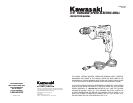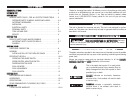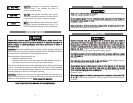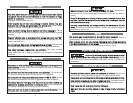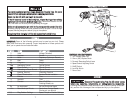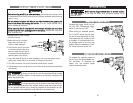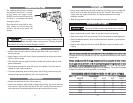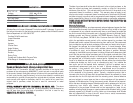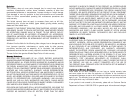
RREEVVEERRSSIINNGG SSWWIITTCCHH LLEEVVEERR
The reversing switch lever reverses
the rotation of the drill bit. It is locat-
ed just above the trigger switch.
ALWAYS turn the motor off and let the
bit come to a complete stop before
moving the switch.
Move the switch to the right for a for-
ward rotation of the bit. Move the
switch to the left to put the bit into
reverse.
Do not change the direction of a moving bit. Make sure the
bit comes to a complete standstill before moving switch. Changing direction
while the bit is moving can cause damage to the drill.
DDRRIILLLLIINNGG WWOOOODD
• Always clamp the work piece to a steady base. Never hold in your hand or
across your legs.
• Apply pressure in line with the bit. Applying pressure at an angle could cause
the bit to bind or break.
• Thin materials that may splinter should be drilled with another piece of wood
placed underneath.
• Twist bits can be used for wood drilling but will overheat if the flutes are not
cleared of wood chips periodically.
• To prevent splintering when finishing holes, stop drilling just before the hole
breaks through and complete the hole from the other side.
DDRRIILLLLIINNGG MMAASSOONNRRYY
• Always use carbide tip bits for drilling masonry.
• Use an even pressure, hard enough to keep the drill biting, but not so hard that
the bit spins in the hole. Spinning the bit will dull it quickly. Bricks and similar
soft materials will take less pressure than a hard material like concrete.
DDRRIILLLLIINNGG MMEETTAALL
• Use an even pressure, hard enough to keep the drill biting, but not so hard that
the bit spins in the hole. Spinning the bit will dull it quickly. Soft metals like
copper, cast iron, brass or aluminum will take less pressure than harder
materials like steel.
• When drilling harder metals, use lubricating oil on the tip of the bit.
MMAAIINNTTEENNAANNCCEE AANNDD CCLLEEAANNIINNGG
Unplug the drill before performing maintenance or cleaning.
• Never immerse tool in liquid. Never let any liquid inside tool housing.
• Clean with a damp cloth and mild soap. Do not use solvents or harsh detergents.
• Check brushes periodically. Worn brushes should be replaced by qualified serv-
ice personnel.
• Keep air vents clean and free from debris. Blocked air vents can lead to over-
heating.
AACCCCEESSSSOORRIIEESS
UUssee oonnllyy aacccceessssoorriieess tthhaatt aarree rreeccoommmmeennddeedd bbyy tthhee mmaannuuffaaccttuurreerr ffoorr yyoouurr mmooddeell..
Accessories that may be suitable for one tool may become hazardous when used on
another tool.
AAllwwaayyss aattttaacchh ggrroouunndde
edd ((33--pprroonngg)) eexxtteennssiioonn ccoorrddss ttoo ggrroouunnddeedd ((33--hhoollee)) oouuttlleettss..
IIff yyoouu mmuusstt uussee aann eexxtteennssiioonn ccoorrdd,, bbee ssuurre
e tthhaatt tthhee ggaauuggee iiss llaarrggee eennoouugghh ttoo ccaarrrryy
tthhee aammoouunntt ooff ccuurrrreenntt nneecceessssaarryy ffoorr yyoouurr ppoowweerr ttooooll..
If not, your tool may experi-
ence a loss of power, excessive voltage drop or overheating. The smaller the gauge
number, the heavier the cord (see table on next page).
RREECCO
OMMMMEENNDDEEDD SSIIZZEESS OOFF EEXXTTEENNSSIIOONN CCOORRDDSS 112200 VVOOLLTT AACC 6600 HHZZ TTOOOOLLSS
TTOOOOLL CCUURRRREENNTT RRAATTIINNGG CCOONNDDUUCCTTOORR SSIIZZEE IINN AA..WW..GG
AMPERE 10FT. 25FT. 50FT. 100FT.
3-6 18 18 18 18
6-8 18 18 18 16
8-10 18 18 18 14
10-12 16 16 14 14
12-16 14 12 12 -
16-20 12 12 12 -
1211



